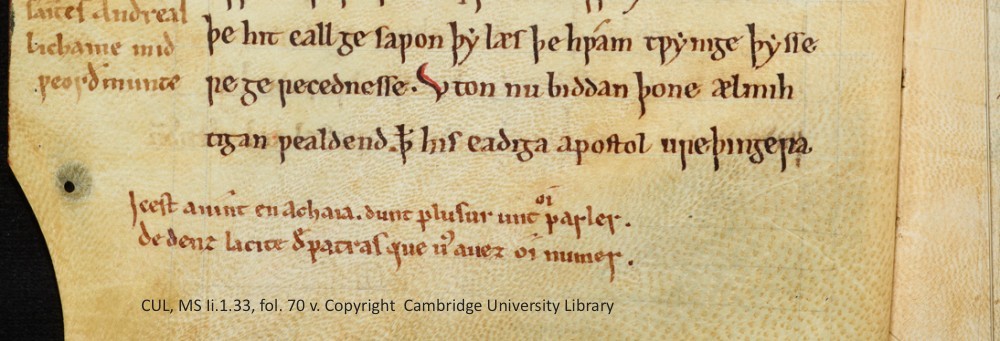
Chaucer’s Troilus and Criseyde focuses its narrative tension through paper: the material itself is essential to the plot of the poem. Troilus both confesses his admiration for Criseyde and later expresses his anxiety about her fidelity through his correspondence. Pandarus’s entire identity is encapsulated by his role as the mediator of these paper communications. Criseyde’s eventual betrayal of Troilus is heralded by her neglect of paper in answering Troilus’s missives. Most striking about paper in this poem, however, is the fact that it is an anachronistic technology at the center of a ‘Troy’ where Martha Rust intriguingly notes that clay tablets would have been in use.[1] Where Orietta Da Rold highlights Chaucer’s deliberate attention to paper itself as a material that underscores both plot and character development while making visible—and tangible—that plot’s most visceral themes,[2] paper is clearly too pivotal for its anachronistic presence to be incidental. This invites the following question: in centering this anachronistic technology, does Troilus and Criseydeinvite further anachronistic engagement?
Note the particular attention paper turns on the fact of Criseyde’s unfreedom; when Criseyde initially voices her aversion to Troilus’s romantic attentions, she uses terms of enslavement:
Allas! Syn I am free,
Should I now love, and put in jupartie
My sikeresse, and thrallen libertee?
Allas, how dorst I thence that folie?[3]
Fixed between ‘freedom’ and ‘thrallen libertee’, Criseyde articulates her position as a commodity object to be brokered between her socially ambitious uncle Pandarus and the reigning prince of Troy, Troilus, who now desires her. Despairing of the “constreinte” and “peyne” that categorize liaisons such as that she now faces,[4] Criseyde continues to underscore the unfreedom of her position: a position that connects her to Igor Kopytoff’s 1986 struggle to recuperate the enslaved body as a recognizable subject, insisting that the enslaved is only a commodity whilst in transit between the homeland from which they have been stripped and the new social nexus by which they will once again be individuated (though, still exploited).[5] This certainly proves to be the case for Criseyde: once Book V of the poem sees her brokered to the enemy Greek camp in exchange for a more valuable Trojan prisoner of war, Criseyde’s use of paper letters take serve to removeher from circulation. The end of transit has delivered into a new space: she has been reunited with her father, delivered from the siege plaguing Troy, and offered protection from Greek soldier Diomedes. Criseyde’s new context has created a new platform from which her paper letters allow her to distance herself from Troilus’s erotic gaze and royal power. Paper replaces her formerly accessible body with letters that Chaucer himself can describe but never render in full (despite fully reproducing Troilus’s letters); Criseyde as a subject eludes masculine access through her deployment of letters.
Female letter-writing in Troilus and Criseyde reacts against the circulation of Criseyde’s body by using paper to protect that body—to distance it from danger, to make it inaccessible, to force a recognition of her cognition rather than foreground the sexual desirability of her form. Paper highlights the ways in which Criseyde as a female object is ‘unfree’ as a commodity in the social interactions between men…and its anachronistic powers invite scholarly interface with another female figure whose unfree, commodified, body is only removed from circulation through her deployment of vernacular English letters that serve to protect her body by making it inaccessible to the man who sees to re-enslave her.
So… If Troilus and Criseyde invites anachronism by situating this anachronistic material at the heart of its letter-driven plot, then what are the comparisons to be made between Criseyde’s unfree, commodified female body using paper to free herself from circulation and, the unfree African-American female body of Harriet Jacobs, whose fictionalized avatar ‘Linda Brent’ used paper just as Chaucer’s Criseyde did?
When Harriet Jacobs’s 1861 Incidents in the Life of a Slave Girl[6] enters the ‘slave narrative’ genre—already well-established by male authors—it revolutionizes genre conventions for women by emphasizing the precarity of their bodies as erotic objects to subject-actors empowered by law and social-standing to fetishize these bodies at will. Her work—like Criseyde’s words—active the enslavement, commodity, and subject vs. actor dichotomy articulated by Kopytoff. Jacobs’s is an extraordinary case: she is the first African-American woman to entirely self-author her own autobiographical anti-slavery narrative[7] and as a literate figure she deploys the act of letter-writing in her quest for physical and legal emancipation. Jacobs famously involves elements of fiction in her autobiographical narrative—changing her own name and that of key figures in her life, openly disavowing the use of concrete place names or timelines in the very Preface to her work.[8] Her narrativized, self-as-character, ‘Linda Brent’ wields letters as Criseyde does: both figures rely on paper to remove her body from circulation, from erotic fetishization, and to place their bodies beyond the reach of the empowered male figure who fetishizes her.

Jacobs’s case represents an extraordinary one: she famously escaped the chattel-slavery of antebellum North Carolina not by fleeing the state, but by hiding in a garret in an abandoned shed on her freed grandmother’s property for seven years. Throughout this time, Jacobs wrote letters “back” to both her grandmother and to the man seeking to re-enslave her.[9]However, she carefully arranged to have those letters post-marked from various addresses in Boston, New York, and even Canada. When we think of the importance of letters to Jacobs, we must understand her letters first as pieces of paper. The material itself—difficult to come by for an enslaved person, illegal to wield as a writing or reading material, absolutely necessary to Jacobs’s pursuit of freedom and the literal difference between her life and death—proves essential throughout Incidents. Upon realizing that she lacks knowledge regarding mailing addresses, streets, etc. that will make her first letter authentic, Jacobs writes of her self-as-character Linda Brent being saved by a scrap of a New York newspaper an ally happens to discover in his pocket: a scrap of paper in the pocket used to insulate a glass bottle purchased the day before. Paper here is not for reading. Its usefulness as insulation and the ordinariness that makes it forgettable all allowed it to engineer this moment: where it can now help secure human emancipation. Paper protects Linda Brent’s body by obscuring her whereabouts; it forces a reckoning with her voice—what she asserts is her “cunning”[10]—while her person remains inaccessible. No longer an object in circulation or transit, paper allows Brent’s subjectivity to be seen.
Paper allows both Linda Brent and Criseyde to undermine female unfreedom in exactly the ways that Sarah Stanbury describes when positing women’s medieval letter-writing as assertions over the female right to privacy, to private space, and to autonomy over the body that in choosing privacy can choose to exit circulation in the public sphere.[11] Stanbury writes: ‘…letters formalize and isolate private from public zones as they materialize a portion of an individual thought and transport it across time and space.’[12] Through paper letters, might be able to commit this anachronistic analogy pairing Jacobs’ Linda Brent to Chaucer’s Criseyde?
This is the question orienting the current Paper Trails investigation.
Both Brent and Criseyde are women in positions of unfreedom who circulate paper in lieu of their bodies to achieve emancipation from sexual exploitation. Both women represent English language, literary, and epistolary ‘firsts’;[13] and both foreground the importance of paper as material means of undermining unfreedom. Is this enough, however, to situate Troilus and Criseyde at the center of a new kind of ‘global Middle Ages’ research, one that connects text using the paper that defines both works—and continues to define their reception as scholars navigate these disparate texts from the same material, and can make the same theoretical moves in both works? Is this further evidence. of ‘technology’ engendering new conversations across new planes of engagement: does this kind of scholarship reinscribe paper’s place as a technology alongside advances of the recent digital work? Questions abound, but the work continues…
Thai-Catherine Matthews, PhD Candidate, Visiting Student to the Faculty of English, University of Cambridge
[1] Martha Rust, ‘Love Stories in Paper in Middle English Verse Love Epistles,’ Journal of the Early Book Society 15 (2012): 101.
[2] Orietta Da Rold, ‘Paper in the Medieval Imagination’ in Paper in Medieval England: From Pulp to Fictions. Cambridge Studies in Medieval Literature, (Cambridge: Cambridge University Press, 2020), 199-200.
[3] Chaucer, Troilus and Criseyde, ed. Stephen A. Barney, II. 771-4.
[4] Ibid, II. 776.
[5] See: “The Cultural Biography of Things: Commoditization as Process” in The Social Life of Things: Commodities in Cultural Perspective, (Cambridge: Cambridge University Press, 1986).
[6] Harriet Jacobs, Incidents in the Life of a Slave Girl, ed. Jean Fagan Yellin, 2nd ed. (Cambridge and London: Harvard University Press, 2009).
[7] Jocelyn Moody, ‘African American Women and the United States Slave Narrative’ in The Cambridge Companion to African American Women’s Literature, eds. Angelyn Mitchell and Danille K. Taylor (Cambridge: Cambridge University Press, 2009), 116.
[8] Jacobs, Incidents, 2.
[9] Jacobs, ‘Competition in Cunning’ in Incidents, 163-8.
[10] Jacobs, ‘Competition in Cunning’ in Incidents, 163-8.
[11] Sarah Stanbury, ‘Women’s Letters and Private Space in Chaucer,’ Exemplaria 6.2 (1994): 271–285.
[12] Ibid, 274.
[13] As stated earlier, the letters depicted in Troilus and Criseyde are English literature’s first vernacular correspondence, making her the English literature’s first female letter-writer to use the vernacular. Similarly, Harriet Jacobs is the first literate African-American woman to write her own narrative of enslavement. See: Moody, ‘African American Women and the United States Slave Narrative’, 116.

